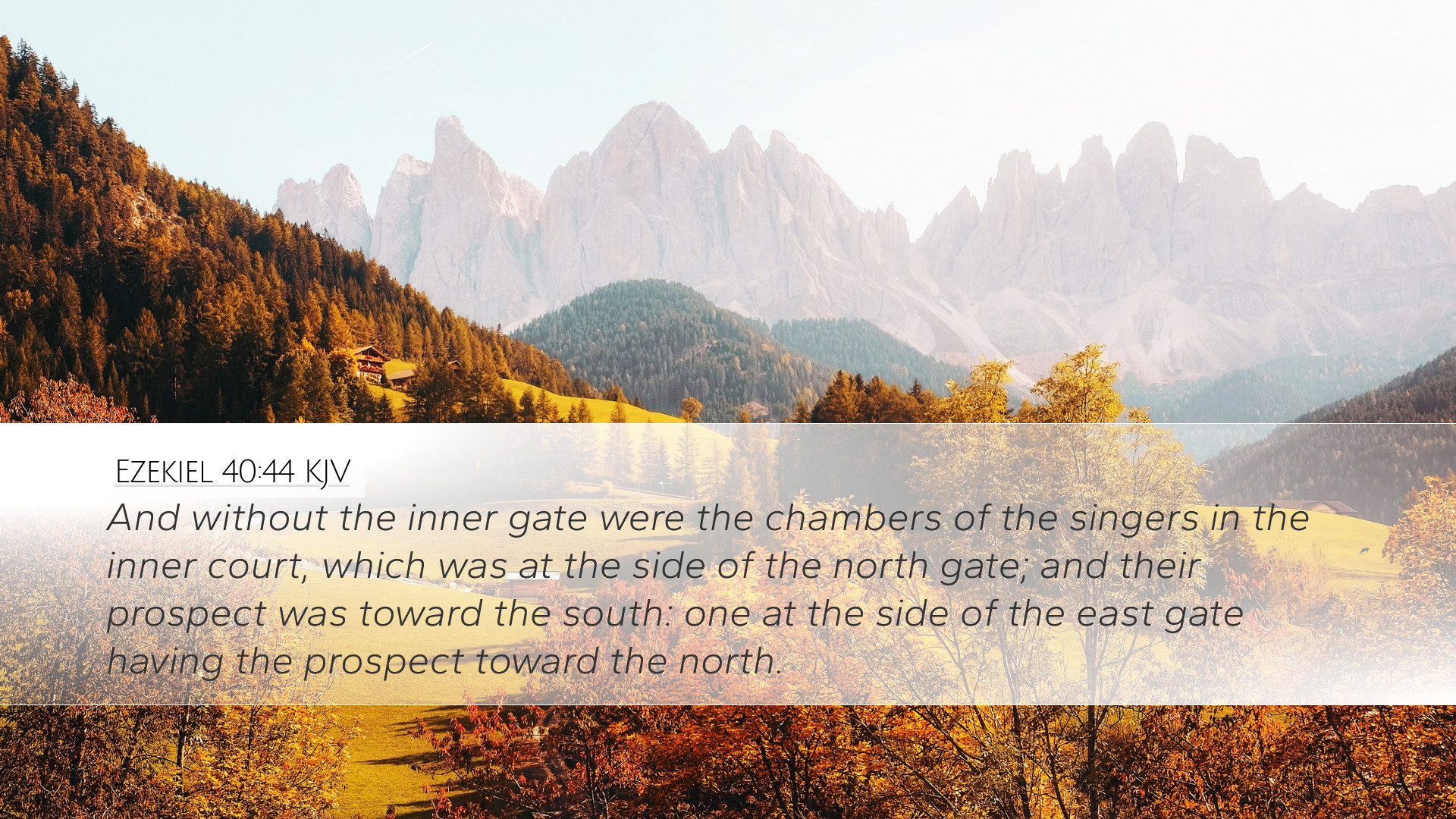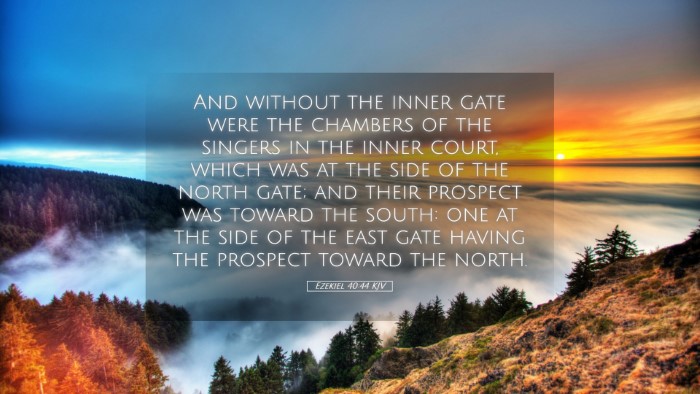Bible Commentary on Ezekiel 40:44
Verse Analysis: Ezekiel 40:44 states, "And without the inner gate were the chambers of the singers in the inner court, which was at the side of the north gate; and their prospect was toward the south; one at the east side, and another at the west side." This verse is part of Ezekiel’s vision of the temple and serves a significant role in understanding the priestly duties of worship and the arrangement of sacred spaces.
Contextual Understanding
The book of Ezekiel was written during a time of great turmoil for the Israelites, particularly during their Babylonian exile. This chapter provides a detailed description of a future temple, which emphasizes the restoration of worship and the presence of God among His people. Scholars agree that Ezekiel's vision serves as both hope for restoration and a reminder of the importance of holiness in worship.
Commentary Insights
Matthew Henry's Commentary
Priestly Functions: Matthew Henry highlights the placement and significance of the chambers of the singers. He notes that music and singing were vital aspects of worship in ancient Israel. The singers here represent those who lead in worship, emphasizing that their chambers are strategically located to facilitate their service. The specificity of their placement indicates God’s order in worship.
Moral Reflection: Henry further reflects that the significance of the singers' chambers points to the fact that worship involves both structure and spirit. He suggests that the heart of worship cannot be separated from its outward expressions, indicating an integrated approach to spiritual practices.
Albert Barnes' Notes
Liturgical Role: Barnes discusses the liturgical role of the singers in the context of the inner court. His commentary emphasizes that the singers’ positioning towards the south indicates an alignment with the temple's sacred worship spaces. This suggests a theological interpretation where the singers facilitate a connection between the worshippers and the divine.
Symbolic Interpretation: Barnes interprets the presence of chambers for singers as symbolic of the joy and beauty of God’s worship. He stresses that singing represents the spiritual response of believers to God’s presence, and these chambers symbolize both preparation and service in worship.
Adam Clarke's Commentary
Geographical Arrangement: Clarke offers an in-depth geographical analysis of the temple layout. He posits that the strategic positioning of the singers' chambers reflects a divine blueprint for worship. Their location adjacent to the north gate emphasizes accessibility to worshippers entering from that direction, reinforcing the communal aspect of worship.
Spiritual Significance: Clarke remarks on the significance of music and song in the life of the community. He notes that worship should be engaging and communal, suggesting a theological underpinning that incorporates the entire community of faith in worship practices.
Theological Implications
This verse speaks volumes about the nature of worship in Israel, revealing that it was not just ritualistic but involved heartfelt participation from the entire community. The inclusion of the singers within the structure of the temple highlights the importance of worship leaders and their role in guiding the congregation into the presence of God.
Worship as a Community Activity
The chambers for the singers suggest that worship involves a community of believers responding to the presence of God. The singers serve as facilitators who lead others in worship, illustrating the communal aspect of praising God. This is an important reminder for pastors and church leaders about the need for cultivated biblical worship practices that encourage participation from the congregation.
The Role of Music in Worship
Music in worship is not merely for entertainment; it carries profound theological significance. The presence of chambers for the singers indicates that music is an essential component of the worship experience. It assists in edifying the believers, stirring emotions, and creating an atmosphere conducive to encountering God.
Implications for Modern Worship
The structure of worship reflected in Ezekiel’s vision challenges the modern church to integrate music thoughtfully into their worship services. It calls for an understanding that worship goes beyond the preacher’s message and involves congregational singing, prayer, and shared expressions of admiration towards God.
Concluding Reflections
In summary, Ezekiel 40:44 not only provides a glimpse into the future temple and its design but also calls believers to a deeper understanding of worship as a holistic expression of faith. Both clergy and laypersons are encouraged to reflect on their roles within the worship setting, acknowledging that music, prayer, and community participation are vital to experiencing the fullness of God’s presence.
Exhortation: As pastors and theologians engage deeply with this text, they are reminded of their responsibility to lead and inspire congregational worship, echoing the joys and reverence of those ancient singers mentioned in Ezekiel’s vision.


